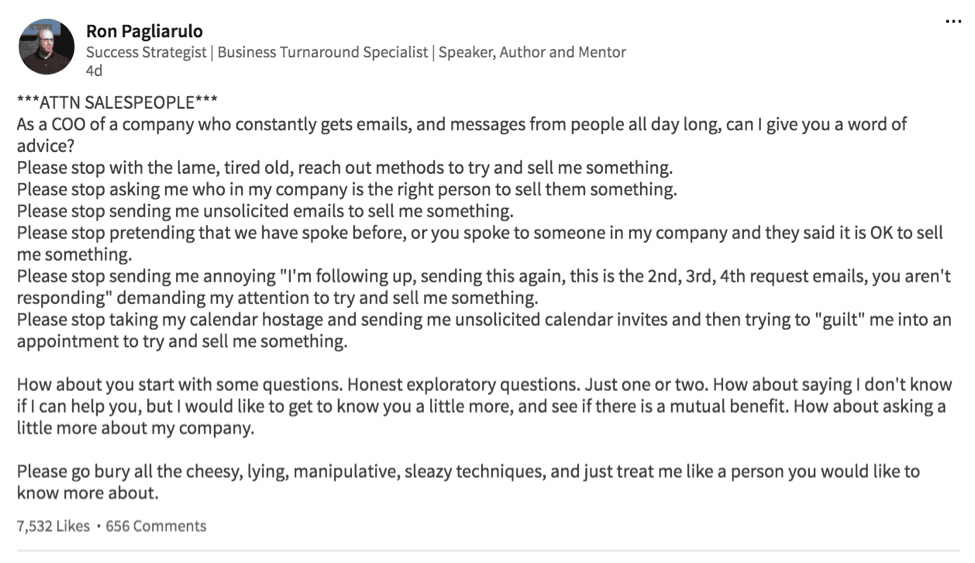Personal Selling: Definition, Real-Life Examples, and Strategies
Melissa Williams
In an era dominated by automation, artificial intelligence, and digital outreach, it might seem that the art of direct, one-on-one sales is a relic of the past. Yet, the truth is precisely the opposite: personal selling remains not just relevant, but an indispensable cornerstone of successful sales strategies, especially for complex products, high-value deals, and relationship-driven markets.
Personal selling is more than just a transaction; it’s the strategic process of a salesperson directly engaging with a prospective buyer to understand their unique needs, build trust, and collaboratively guide them toward a solution. It’s where authentic human connection transforms interest into commitment, adapting in real-time to create tailored value.
This comprehensive guide will delve into why personal selling continues to be a critical competitive advantage. We’ll explore its fundamental definition, distinguish it from personal branding, unpack its unique benefits, detail the essential skills required for mastery, and walk through its step-by-step process. Furthermore, we’ll examine how personal selling thrives in the modern digital landscape and how to measure its impact, equipping you with the knowledge to harness its full power for your sales success.
Here’s what we’ll cover:
- What Is Personal Selling?
- Personal Selling Advantages & Disadvantages
- Types of Personal Selling
- The Opposite of Personal Selling
- Personal Selling Process
- How to Get Started with Personal Selling
- 5 Personal Selling Examples
- Personal Selling in the Modern Era: High-Tech Meets High-Touch
- Measuring Success: Key Metrics for Personal Selling
- Common Personal Selling Mistakes (and How to Avoid Them)
- FAQs
What Is Personal Selling?
At its heart, personal selling is a dynamic form of direct sales where a salesperson interacts one-on-one with a prospective buyer. This interaction can occur in a variety of settings: traditionally face-to-face in a physical location, over the phone, through video conferencing, or via highly personalized email exchanges. Unlike mass marketing efforts, personal selling is characterized by this direct, individualized engagement, allowing for immediate feedback and tailored communication.
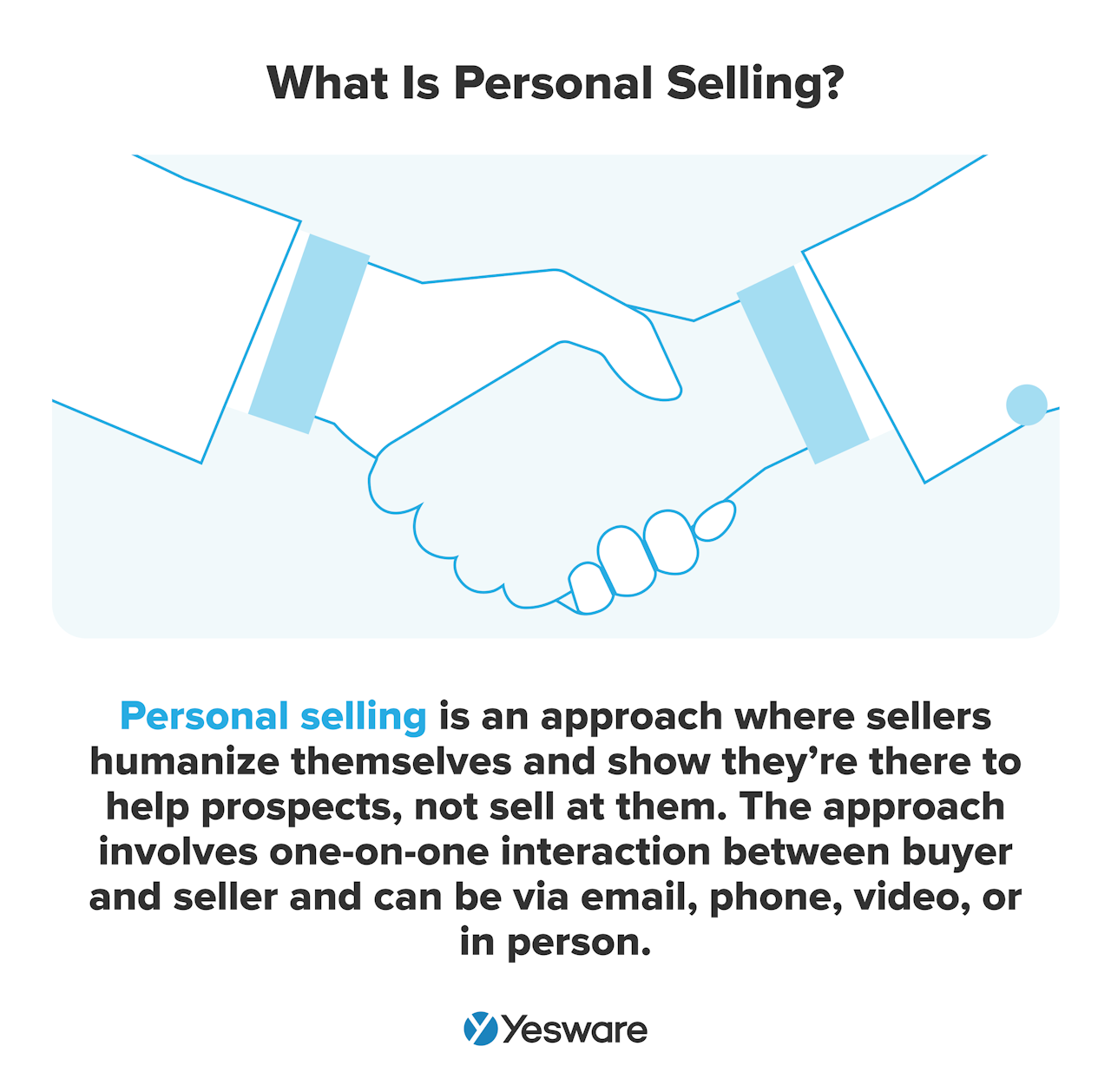
What sets personal selling apart from other sales and marketing strategies is its inherent qualities that foster deeper connections and drive better results:
- Two-Way Communication and Immediate Feedback: Unlike advertising or mass email campaigns, personal selling thrives on dialogue. Salespeople can ask questions, listen actively to responses, and immediately address concerns or objections. This real-time interaction allows for a much more nuanced understanding of the prospect’s needs and challenges.
- Adaptability and Customization: The one-on-one nature enables salespeople to adapt their sales pitch, language, and solutions in real-time based on the prospect’s verbal and non-verbal cues. This unparalleled flexibility ensures the message always resonates, making the solution feel truly bespoke.
- Relationship-Building at its Core: Personal selling isn’t just about transactions; it’s fundamentally about building rapport, trust, and empathy. Salespeople can establish genuine connections, understand the prospect’s emotional drivers, and position themselves as a trusted advisor, leading to stronger, longer-lasting customer relationships.
Evolution of Personal Selling: Adapting to the Digital Age
While its core principles remain constant, personal selling has dramatically evolved with technology. Historically, it was largely an in-person, face-to-face activity. Today, while still vital for many industries, its reach has expanded to encompass sophisticated digital channels:
- Phone and Video Conferencing: These channels allow for direct vocal and visual interaction, replicating many benefits of in-person meetings without geographical limitations.
- Personalized Email and Messaging: Far beyond mass blasts, modern personal selling leverages highly personalized email campaigns and direct messages on platforms like LinkedIn to initiate contact, nurture leads, and share relevant information in a one-on-one manner.
- Social Selling: Engaging with prospects on social media by providing value and building credibility can open doors for direct, personalized sales conversations.
Personal Selling vs. Personal Branding: A Key Distinction
While both terms involve a person’s professional presence, it’s crucial to distinguish between personal selling and personal branding:
- Personal Selling: This is an active, two-way process focused on guiding a specific prospect through a sales conversation with the immediate goal of closing a deal or moving an opportunity forward. It’s about directly influencing a purchasing decision through dialogue and problem-solving.
- Personal Branding: This is a passive, ongoing process focused on cultivating and projecting your professional reputation, expertise, and unique value proposition to a broader audience. It’s about establishing credibility and attracting opportunities over time, often through content creation, networking, and thought leadership, rather than direct sales pitches.
Think of it this way: Your personal brand is the magnet that attracts interest; personal selling is the focused conversation you have once someone is drawn to your magnetic field, converting that interest into a concrete outcome.
Personal Selling Advantages and Disadvantages
Although there are immense benefits of personal selling, there are some disadvantages to this type of selling. Let’s look at both the advantages and disadvantages below.
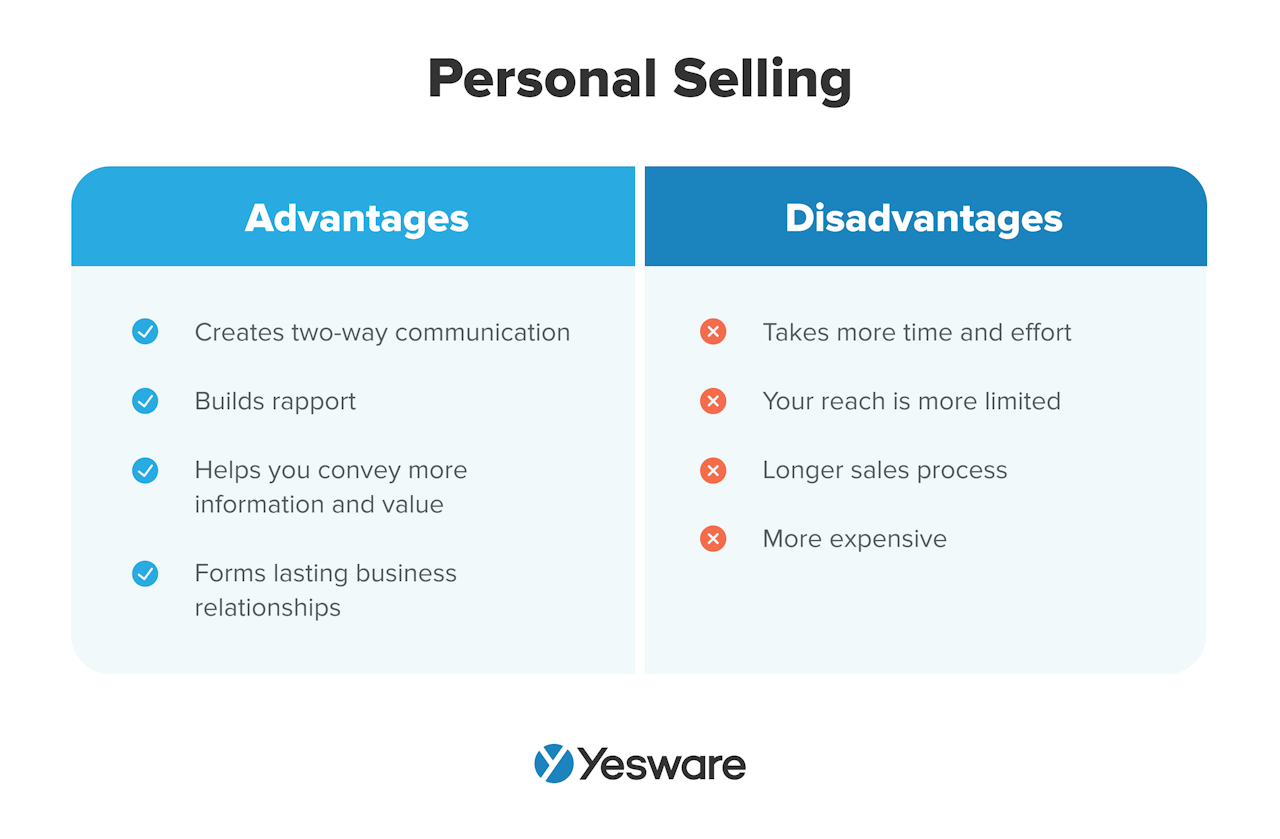 Personal Selling Advantages
Personal Selling Advantages
1. Building Unshakeable Trust and Lasting Relationships
Personal selling thrives on direct human interaction, which is the bedrock of trust. Unlike impersonal advertisements or automated emails, a direct conversation allows salespeople to genuinely connect with prospects, build rapport based on shared understanding, and establish credibility. This human connection fosters a sense of reliability and transparency, paving the way for not just a single transaction, but long-term customer loyalty and advocacy. Prospects are more likely to buy from, and stay with, someone they trust.
2. Unmatched Customization and Real-time Adaptability
One of the most powerful benefits of personal selling is its unparalleled flexibility. A skilled salesperson can:
- Tailor Solutions in Real-time: As they engage with a prospect, they can instantly adapt their pitch, focus on specific features that resonate most, and reshape the solution to fit the exact needs and pain points being uncovered.
- Leverage Immediate Feedback: The two-way dialogue allows for instant clarification of doubts, direct responses to questions, and real-time adjustments to the sales approach based on the prospect’s verbal cues, body language, and immediate reactions. This dynamic interaction ensures the conversation remains highly relevant and impactful.
3. Driving Higher Conversion Rates
The personalized nature of personal selling directly translates to more closed deals. When a salesperson can directly engage with a prospect:
- Direct Objection Handling: They can immediately address concerns, counter objections with empathy and precision, and provide the specific reassurance needed to move forward. This prevents prospects from getting stuck on doubts that might halt a purely digital sales process.

- Deep Understanding of Needs: The ability to ask probing questions and truly listen allows for a profound understanding of the prospect’s underlying motivations and problems. This deep insight enables the salesperson to present solutions that are not just good, but perfectly aligned with the prospect’s core requirements, significantly increasing the likelihood of conversion.
4. Effectively Conveying Complex or High-Value Information
For products or services that are intricate, highly technical, or represent a significant investment, personal selling is often the most effective, if not the only, viable sales method.
- Ideal for Intricate Solutions: Salespeople can break down complex features into digestible benefits, explain technical jargon, and walk prospects through multifaceted solutions in a way that written materials or static presentations simply cannot.
- Justifying Significant Value: When the stakes are high, prospects need more than just information; they need reassurance, expert guidance, and the ability to ask detailed questions. A personal seller can effectively convey the comprehensive value, mitigate perceived risks, and build the necessary confidence for a large investment.
5. Gathering Invaluable Market Intelligence
Every personal selling interaction is a rich source of qualitative data. Salespeople are on the front lines, directly engaging with the market.
- Unfiltered Feedback: They gather real-time insights into customer pain points, competitive offerings, market trends, evolving needs, and product desires that might not be captured through surveys or analytics alone.
- Informing Strategy: This direct, unfiltered feedback from prospects and customers is invaluable for product development, marketing strategy refinement, and overall business intelligence, driving continuous improvement across the organization.
6. Fostering Long-Term Customer Loyalty and Advocacy
The benefits of personal selling extend far beyond the initial transaction. The relationships built during the sales cycle lay the groundwork for enduring customer loyalty.
- Post-Sale Nurturing: Salespeople, or the customer success teams they hand off to, can continue to serve as trusted advisors, ensuring product adoption, addressing post-purchase questions, and identifying opportunities for upselling or cross-selling.

- Building Advocates: Customers who feel genuinely valued and supported by their salesperson are more likely to become vocal advocates for your brand, providing testimonials, referrals, and positive word-of-mouth marketing, which are invaluable assets for future growth.
Personal Selling Disadvantages
While undeniably powerful, personal selling is not without its drawbacks. Understanding these limitations is crucial for businesses to implement personal selling strategically, balance it with other sales and marketing efforts, and mitigate potential downsides. Over-reliance on personal selling without acknowledging its challenges can lead to inefficiencies and unexpected costs.
Here are the key disadvantages associated with personal selling:
1. High Cost Per Contact
Personal selling is inherently a high-investment strategy, making it significantly more expensive per customer reached compared to mass marketing or digital campaigns.
- Personnel Costs: This includes salaries, commissions, bonuses, and benefits for the sales team.
- Training and Development: Investing in ongoing training to refine skills, product knowledge, and sales methodologies.
- Operational Expenses: Travel expenses, entertainment budgets, sales tools, and administrative support add to the overall cost. For smaller businesses or low-margin products, this cost can be prohibitive.
2. Limited Reach and Scalability Challenges
The one-on-one nature that gives personal selling its power also severely limits its reach.
- Finite Capacity: Each salesperson can only manage a finite number of active opportunities at any given time, restricting the total number of prospects that can be engaged.
- Slow Scalability: Rapidly increasing market penetration requires hiring and training a large sales force, which is a slow, expensive, and complex process. It’s not suitable for quickly reaching a vast, undifferentiated audience.
3. Inconsistency in Message and Performance
The human element, while a strength, can also be a weakness in terms of consistency.
- Reliance on Individual Skill: The quality of the sales presentation and the overall customer experience can vary significantly from one salesperson to another, impacting brand consistency.

- Potential for Misrepresentation: While trained, individual reps might inadvertently or intentionally misrepresent product features, pricing, or company policies, leading to customer dissatisfaction.
- Varying Motivation: Sales performance can be highly dependent on individual motivation, skill levels, and even daily moods, leading to unpredictable results across the team.
4. Time-Consuming and Longer Sales Cycles (for certain products)
Despite its ability to accelerate complex deals, personal selling often involves a longer overall sales cycle compared to transactional e-commerce, especially for mid-range or lower-value products.
- Multiple Touches Required: Building rapport, conducting deep discovery, and addressing multiple stakeholders can extend the time from initial contact to close.
- Repeated Efforts: Salespeople often need numerous follow-ups, meetings, and presentations, which can be time-intensive for both the seller and the buyer.
5. High Attrition and Turnover Rates
The sales profession, particularly in roles heavily reliant on personal selling, often experiences higher turnover than other departments.
- Pressure and Quotas: The constant pressure to meet targets and quotas can lead to burnout.
- Rejection Fatigue: Frequent rejections can be emotionally taxing, impacting morale and leading to attrition.
- Recruitment Challenges: Finding, hiring, and retaining top-tier sales talent is an ongoing challenge for many organizations.
6. Potential for Ethical Concerns and Pushiness
The direct nature of personal selling can sometimes lead to negative perceptions or ethical dilemmas if not managed properly.
- Perception of Pushiness: An overly aggressive or manipulative approach can alienate prospects and damage the company’s reputation.
- Information Asymmetry: There’s potential for salespeople to exploit information asymmetry if prospects are less knowledgeable about the product or market.
- Customer Discomfort: Some buyers simply prefer to research independently and dislike direct, unsolicited sales approaches.
Recognizing these disadvantages allows businesses to implement personal selling judiciously, investing in proper training, leveraging technology to mitigate limitations, and integrating it seamlessly with other marketing and sales channels for a holistic and effective go-to-market strategy.
Types of Personal Selling
Personal selling is not a monolithic activity; it manifests in various forms, each suited to different sales environments, product complexities, and customer needs. Understanding these different types allows businesses to tailor their sales strategies and train their teams for maximum effectiveness, ensuring the right approach is applied to the right situation.
Here are the primary ways personal selling can be categorized:
1. By Sales Approach or Methodology
This classification focuses on how the salesperson interacts with the prospect and the underlying philosophy guiding their actions.
- Consultative Selling: In this approach, the salesperson acts as a trusted advisor and problem-solver. They prioritize understanding the customer’s needs, challenges, and goals through in-depth questioning and active listening. The focus is on recommending a solution that genuinely addresses the customer’s specific situation, even if it means a longer sales cycle. This is common in B2B sales of complex software, financial services, or strategic consulting.

- Transactional Selling: This is a more straightforward, often shorter-cycle approach where the emphasis is on making a quick sale of a readily available product or service. The customer typically already knows what they want, and the salesperson’s role is to facilitate the purchase, handle simple objections, and process the order efficiently. Examples include retail sales of consumer goods or telemarketing for a clear-cut service.
- Relationship Selling: While building relationships is a component of all personal selling, relationship selling explicitly prioritizes nurturing long-term connections over immediate transactions. Salespeople focus on building rapport, trust, and mutual understanding, often extending beyond the immediate sale to cultivate loyalty and future business. This approach is vital in industries like client management, high-net-worth financial advising, or large-scale B2B accounts.

- Solution Selling: Similar to consultative selling, solution selling involves identifying a customer’s specific problem and then presenting the product or service as the ultimate solution. It often involves diagnosing complex issues and demonstrating how the offering directly resolves the pain points, sometimes even before the customer fully articulates them. This is prevalent in technology sales, enterprise software, or systems integration.

- Stimulus-Response Selling (or “Formula Selling”): This is a more traditional, often high-pressure approach where the salesperson uses a pre-planned pitch or series of statements designed to elicit a positive response (stimulus-response). While less common in modern complex sales, elements of this can be found in some direct sales scenarios or telemarketing where sales reps follow a clear sales call script.
2. By Sales Environment or Context
This categorization defines the setting or target audience for the personal selling effort.
- Retail Sales: This involves direct, in-person interaction between a salesperson and a consumer within a retail store environment. The salesperson assists customers with product selection, answers questions, and facilitates the purchase. Examples include car dealerships, electronics stores, or fashion boutiques.
- Business-to-Business (B2B) Sales: Here, salespeople sell products or services from one business to another. These sales often involve multiple decision-makers, longer sales cycles, and more complex solutions requiring extensive customization and relationship building. Examples include enterprise software sales, industrial equipment sales, or consulting services.
- Direct Selling (Direct-to-Consumer): This method bypasses traditional retail channels, with salespeople selling directly to consumers, often outside of a fixed retail location. It emphasizes personal interaction and product demonstration. Sub-types include:
- Door-to-Door Selling: Salespeople visit consumers’ homes directly.
- Home Party Selling: Salespeople demonstrate products to a group of potential customers at a host’s home (e.g., Tupperware parties).
- Multi-Level Marketing (MLM): Distributors sell products and also recruit others to sell, earning commissions on their own sales and those of their recruits.
- Telemarketing: This involves sales professionals initiating contact with prospects over the phone to promote or sell products or services. It can be used for both B2B and B2C contexts, ranging from simple product offers to initial qualification calls for more complex sales.
3. By Interaction Channel
In the digital age, how the direct communication occurs is also a key differentiator.
- In-Person Personal Selling: This is the traditional face-to-face interaction, allowing for full sensory engagement (body language, visual cues, tone of voice) and often leading to the deepest level of rapport. It’s crucial for high-stakes negotiations, complex demonstrations, or relationship-driven sales.
- Virtual Personal Selling: Leveraging technology, this includes video calls, personalized emails, and direct messaging on social platforms. It allows for one-on-one interaction across geographical barriers, offering scalability while retaining much of the personalized touch. While it might lack some in-person nuances, tools (like Yesware) enhance tracking and efficiency for effective virtual engagement.
- Social Selling: While not a standalone “type” in the traditional sense, social selling is a modern approach that leverages social media platforms to identify, connect with, and engage potential customers. It focuses on building credibility and relationships online that can eventually lead to a direct, personalized sales conversation.
By recognizing these diverse types, sales organizations can strategically deploy their resources, train their teams in the most relevant methodologies, and optimize their sales processes to effectively reach and convert their target audiences.
How to Piss People Off: The Opposite of Personal Selling
We’ve all been there.
Something that, by its nature, irks you happens again, and again, and again — but you brush it off because you can just focus on other things.
Until someone totally calls it out for you, and you’re like, “YES!”
The bad news: You might be the thing annoying your prospects right now (whoops). We get it, you have a quota. But there’s a person on the other end of that email, and your “respectful persistence” is actually pissing them off. To the point that you’re hurting your chances of getting them to take a meeting with you.
The good news: You can actually become the person who identifies what’s annoying them and shows them that there’s a way to totally eliminate it. More on this later.
What to Avoid When Personal Selling
For right now, just remember that you need to avoid these sources of frustration:
- Leading with who you are and what your company does instead of their situation.
- Telling them that you want to talk rather than asking them if they are interested.
- Personalizing a line to them while still being pushy — that’s just putting lipstick on a pig.
With each of the scenarios above, your recipient reads your email the same, no matter what it actually says: “Hi faceless prospect, I have a quota and am worried about me. Confirm a meeting time or else.”
Not the most appealing, right?
We already spend 35% of our workday in meetings that we schedule and we are required to attend. Why would we add another?
Getting to “yes” with a meeting request requires two things: 1) that they agree with you that their time is worth it, and 2) their preferred mode of communication to gather info is to have a call.
Studies show that introverts make up one-third to one-half of the population, and they dislike having meetings where they haven’t info-gathered on their own first. Booking a meeting just to tell them more is not their cup of tea.
What to do about it:
- Read over any professional email before you send it, and ask yourself: If I were the person receiving this email, would I say “yes” to this request?
- If you do ask for a meeting, be specific about what they would get out of that phone call that they can’t learn on their own.
- Think through your tendency to ask for a call. Is there a more engaging way to ask, or a better way to start a conversation that qualifies the match for both of you?
Personal Selling Process
Effective personal selling isn’t a random sequence of interactions; it’s a structured, systematic process designed to guide a prospect from initial awareness to becoming a satisfied customer. By mastering each stage, sales professionals can build rapport, uncover needs, present compelling solutions, and ultimately drive successful outcomes.
Here’s a detailed breakdown of the personal selling process.
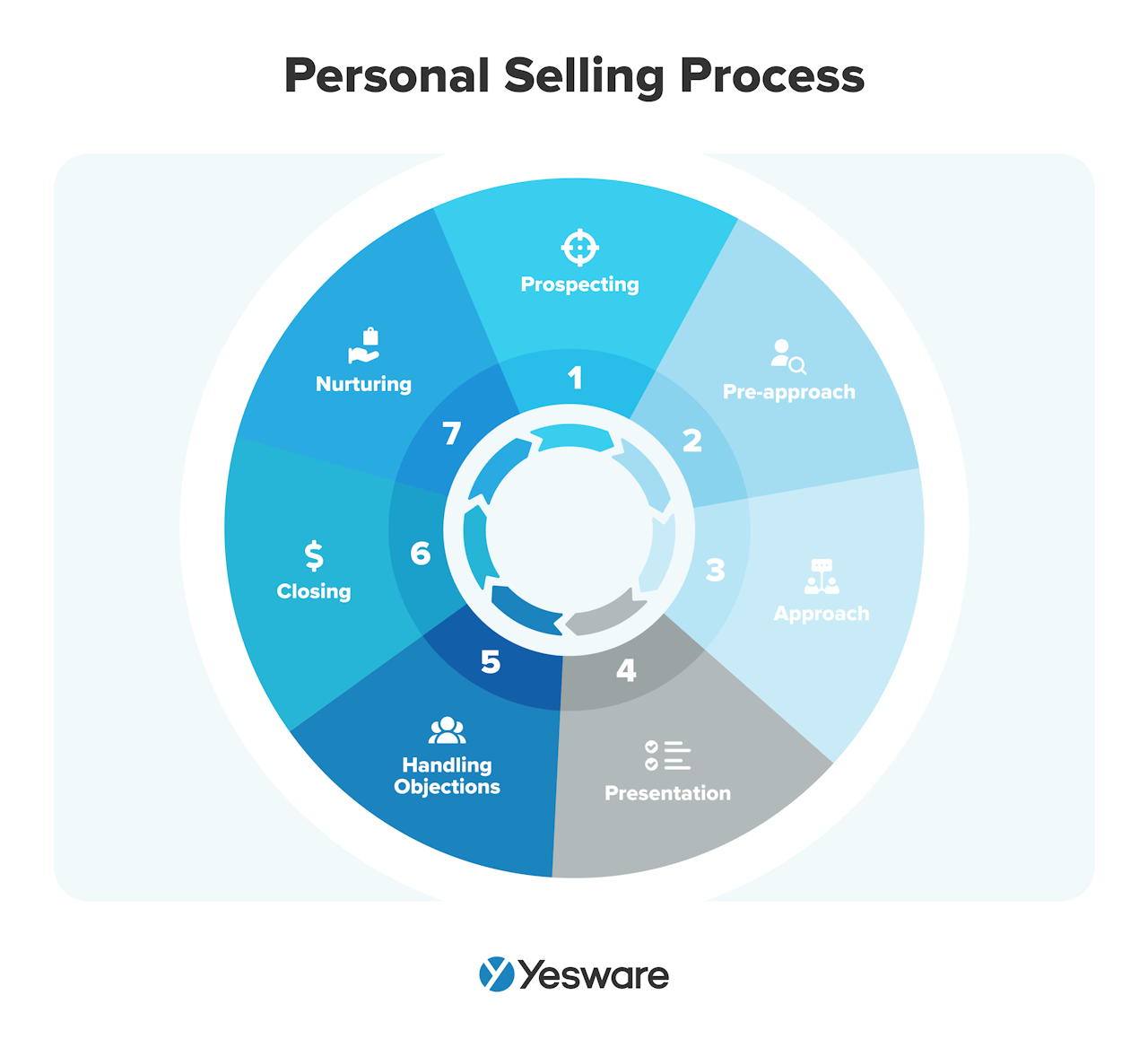
1. Prospecting
Definition: Prospecting involves systematically identifying and researching potential customers (prospects) who fit your Ideal Customer Profile (ICP) and are most likely to benefit from your product or service.
Key Activities:
- Defining your target market and buyer personas.
- Researching companies and individuals using CRM data, LinkedIn Sales Navigator, industry databases, and online search.
- Analyzing current customers for common traits and success stories.
- Lead qualification through various channels (e.g., referrals, cold outreach lists, inbound inquiries).
Actionable Tips:
- Quality over Quantity: Focus your efforts on highly qualified leads who genuinely align with your ICP to save time and resources.
- Leverage Technology: Use sales intelligence tools to enrich prospect data and identify decision-makers.
- Stay Updated: Continuously refine your ICP and buyer personas based on market shifts and customer insights.
Goal for the Stage: To create a robust sales pipeline of high-potential individuals or organizations to approach.
2. Pre-approach
Definition: Before making any direct contact, the pre-approach stage involves thorough pre-call planning research and preparation to understand the prospect’s needs, challenges, and context as deeply as possible.

Key Activities:
- Gathering intelligence on the prospect’s company (industry trends, news, financial performance, competitors).
- Researching the individual prospect (their role, recent achievements, common connections, social media presence).
- Identifying potential pain points or opportunities relevant to your offering.
- Planning your initial contact strategy, including potential hooks or value propositions.
Actionable Tips:
- Go Beyond the Surface: Look for trigger events (e.g., new funding, leadership changes, recent product launches) that indicate a current need.
- Formulate Hypotheses: Based on your research, create educated guesses about their challenges that you can validate during the initial conversation.
- Prepare Opening Questions: Craft insightful questions that demonstrate your research and open up a dialogue about their specific situation.
Goal for the Stage: To equip yourself with enough relevant information to personalize your initial outreach and demonstrate immediate value, increasing the likelihood of securing a first conversation.
3. Approach
Definition: This is the actual initiation of contact with the prospect, where the salesperson makes their first direct impression and aims to capture attention and interest.
Key Activities:
- Executing cold calls, sending personalized emails, or reaching out via professional social networks (e.g., LinkedIn).
- Delivering a concise and compelling opening statement or value proposition that speaks directly to a potential pain point or benefit for the prospect.
- Building initial rapport and establishing credibility.
- Setting the agenda for a potential deeper conversation.
Actionable Tips:
- Lead with Value, Not Your Product: Frame your opening around a potential benefit or solution to a common problem your ideal customers face. Ask open-ended questions to gauge as much information as possible about the prospect so that you can tailor your pitch to their specific needs.

- Be Brief and Respectful of Time: Get to the point quickly, especially on cold calls or initial emails.
- Master Your Tone: Project confidence, curiosity, and warmth.
- Use a Clear Call-to-Action: Clearly state what you want the prospect to do next (e.g., “Would you be open to a brief 15-minute chat?”).
Goal for the Stage: To secure a follow-up conversation or a dedicated discovery meeting where you can delve deeper into their needs.
4. Presentation
Definition: In this stage, the salesperson formally presents their product or service as a solution to the prospect’s identified needs and challenges. This often involves a demonstration.
Key Activities:
- Customizing the presentation/demo to highlight features and benefits most relevant to the prospect’s specific pain points and goals.
- Connecting features directly to the prospect’s desired outcomes and potential ROI.
- Using visuals, stories, and data to make the solution tangible and compelling.
- Engaging multiple stakeholders from the prospect’s side, if applicable.
Actionable Tips:
- Focus on “Why Them”: Every part of your presentation should answer “What’s in it for me (the prospect)?” rather than just listing features.
- Tell Success Stories: Share relatable examples of how other customers have achieved similar results.
- Encourage Interaction: Ask questions throughout the presentation to ensure understanding and maintain engagement.
- Practice Active Listening (Still!): Listen for subtle cues of interest or concern, allowing you to adapt on the fly.
Goal for the Stage: To gain the prospect’s agreement that your proposed solution effectively addresses their needs and provides significant value, making them ready to consider next steps towards purchase.
5. Handling Objections
Definition: This crucial stage involves actively listening to, acknowledging, and effectively addressing any concerns, questions, or sales objections the prospect raises about the product, price, timing, or company.

Key Activities:
- Listening carefully and empathetically to understand the root of the objection.
- Validating the prospect’s concern before attempting to resolve it.
- Asking clarifying questions to ensure you fully grasp the objection.
- Providing well-reasoned responses that reaffirm value, mitigate risk, and offer solutions.
Actionable Tips:
- Embrace Objections: View them as signs of engagement and opportunities to provide more information, not as rejections.
- Prepare Common Responses: Have a playbook for frequently asked questions or concerns, but deliver them naturally.
- Don’t Argue: Focus on understanding and educating, rather than debating.
- Reframe Objections: Practice a positive sales mindset and turn perceived negatives into positives (e.g., “The price seems high” becomes “I understand. Many clients initially feel that way, but they find the ROI from X and Y features quickly justifies the investment…”).

Goal for the Stage: To resolve all outstanding concerns and move the conversation forward towards a definitive decision, ensuring the prospect feels understood and confident.
6. Closing
Definition: This is the pivotal stage where the salesperson guides the prospect to make a purchasing decision and formally commit to the deal.
Key Activities:
- Summarizing the agreed-upon value proposition and terms.
- Asking for the business directly (e.g., using a direct close, assumptive close, or alternative-choice close).
- Addressing any last-minute hesitations.
- Guiding the prospect through the necessary paperwork or digital signing process.
Actionable Tips:
- Be Confident and Direct: Once value is established and objections handled, ask for the sale clearly and without hesitation.
- Assume the Close: Use language that implies the decision has already been made and you’re just confirming logistics (e.g., “When would you like to begin implementation?”).
- Reiterate Benefits: Briefly remind them of the core value they’re about to gain.
- Silence is Golden: After asking for the close, stop talking and wait for their response.
Goal for the Stage: To obtain a verbal or written commitment to purchase the product or service.
Pro Tip: Learn how to close a sale like a pro with these 22 powerful sales closing phrases.

7. Nurturing/Following Up
Definition: This crucial post-sale stage involves ensuring customer satisfaction, facilitating successful onboarding, and nurturing the relationship to foster loyalty, advocacy, and future business opportunities.
Key Activities:
- Seamlessly handing off to customer success or support teams.
- Conducting follow ups to ensure smooth implementation and initial positive experience.
- Providing ongoing value, support, and relevant information.
- Identifying opportunities for upselling, cross-selling, or referrals.
- Soliciting testimonials or case studies from satisfied customers.
Actionable Tips:
- Don’t Disappear: Maintain communication even after the deal is closed. This builds trust for future engagements.
- Focus on Customer Success: Your role shifts from selling to ensuring they achieve the value they invested in.
- Request Referrals Thoughtfully: Once they’re seeing value, ask for introductions to other potential prospects.
- Stay Informed: Keep track of their evolving needs to identify future sales opportunities.
Goal for the Stage: To cultivate a long-term, mutually beneficial relationship that drives customer retention, encourages advocacy, and creates avenues for recurring revenue.
How to Get Started with Personal Selling
Embarking on a journey to master personal selling can feel daunting, but by focusing on foundational frameworks, you can quickly develop a systematic approach that drives meaningful connections and accelerates deals. These two approaches provide actionable blueprints for initiating and deepening prospect relationships.
The PBR Approach
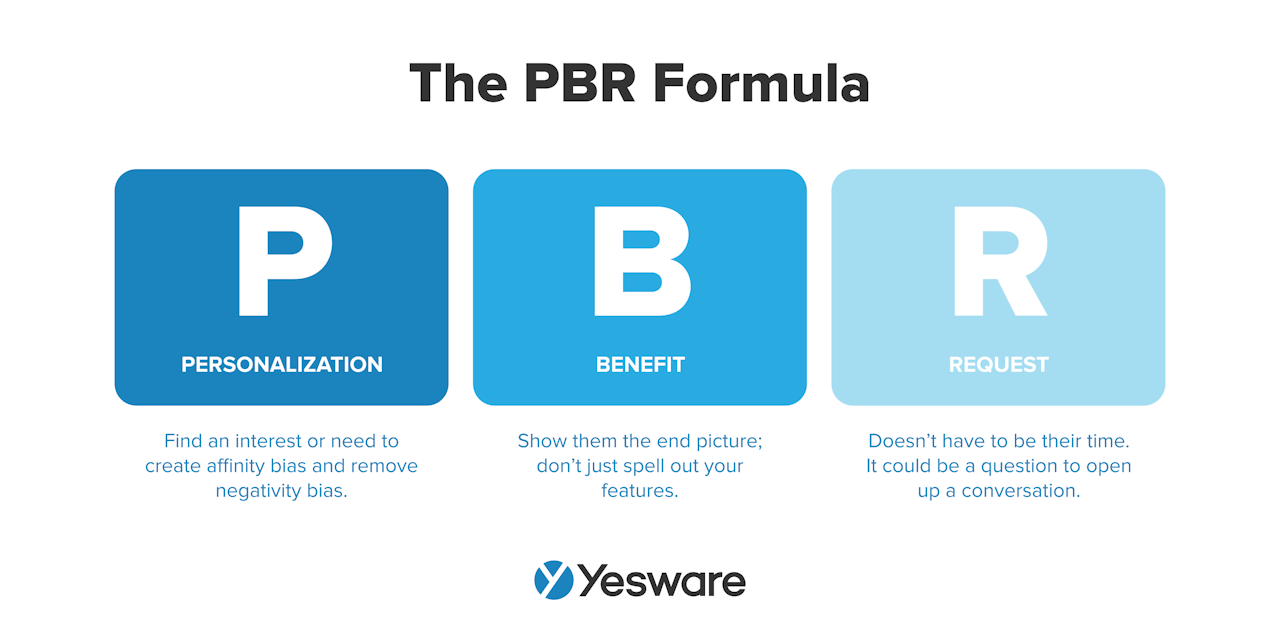
The PBR (Personalization, Benefit, Relate) approach is a powerful framework for crafting compelling initial sales messages—especially in email and cold outreach—that cut through the noise and resonate with prospects. It shifts the focus from “what I sell” to “what I understand about them.”
- Personalization (P): Start by demonstrating genuine research and understanding of the prospect or their company. This isn’t just about their name; it’s about a specific detail, recent event, challenge, or interest that shows you’ve done your homework.
- Benefit (B): Clearly articulate a direct, quantifiable benefit that your product or service can provide to them, specifically addressing the pain point or opportunity you’ve identified through your personalization. Focus on the outcome, not just the features.
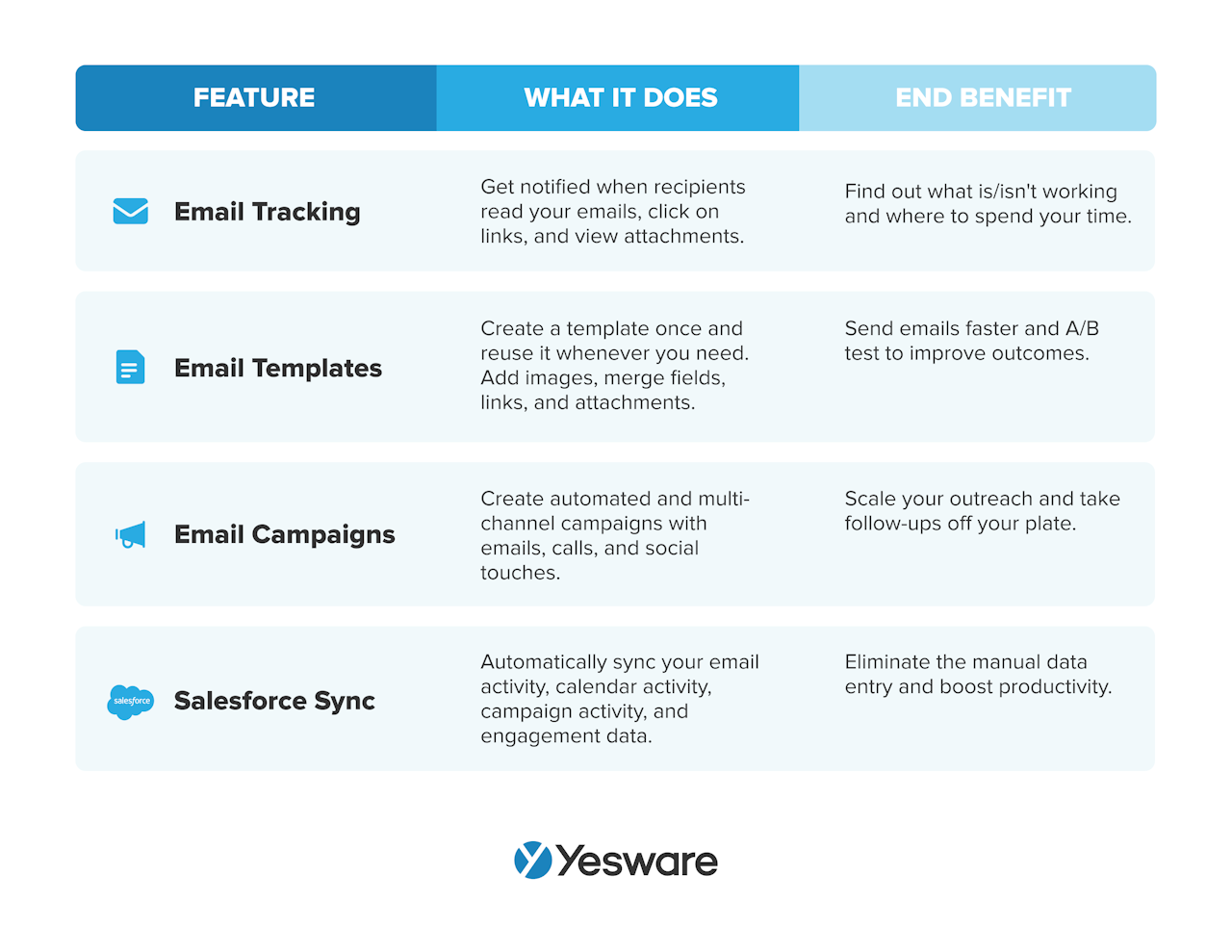
- Relate (R): Connect the dots between their specific situation and the value you offer. Show them how your solution is relevant to their unique context, often by referencing similar challenges or goals you’ve helped others achieve.
How it works in an email:
Let’s say you sell a project management tool, and you noticed a prospect’s company recently expanded, which often leads to communication challenges.
Subject: Quick thought on [Prospect Company]’s recent growth
Hi [Prospect Name],
I noticed your team recently expanded by 20% in Q2, which is fantastic growth! (P – Personalization)
Often, teams experience communication bottlenecks and project delays when scaling rapidly like that. Our platform helps growing companies streamline project workflows by centralizing all communication and task management, typically reducing miscommunications by 30%. (B – Benefit)
This means your teams can stay aligned and deliver projects on time, even as you continue to grow. Does that resonate with any challenges your team is currently navigating? (R – Relate + Soft CTA)
Best, [Your Name]
Remember, our brains are wired to love talking about ourselves. Use this to your advantage by focusing on them to start a conversation with your prospect.
To help you get started, below are five real personal selling emails that booked meetings.
Tip: Perfect your sales outreach with these data-backed findings.
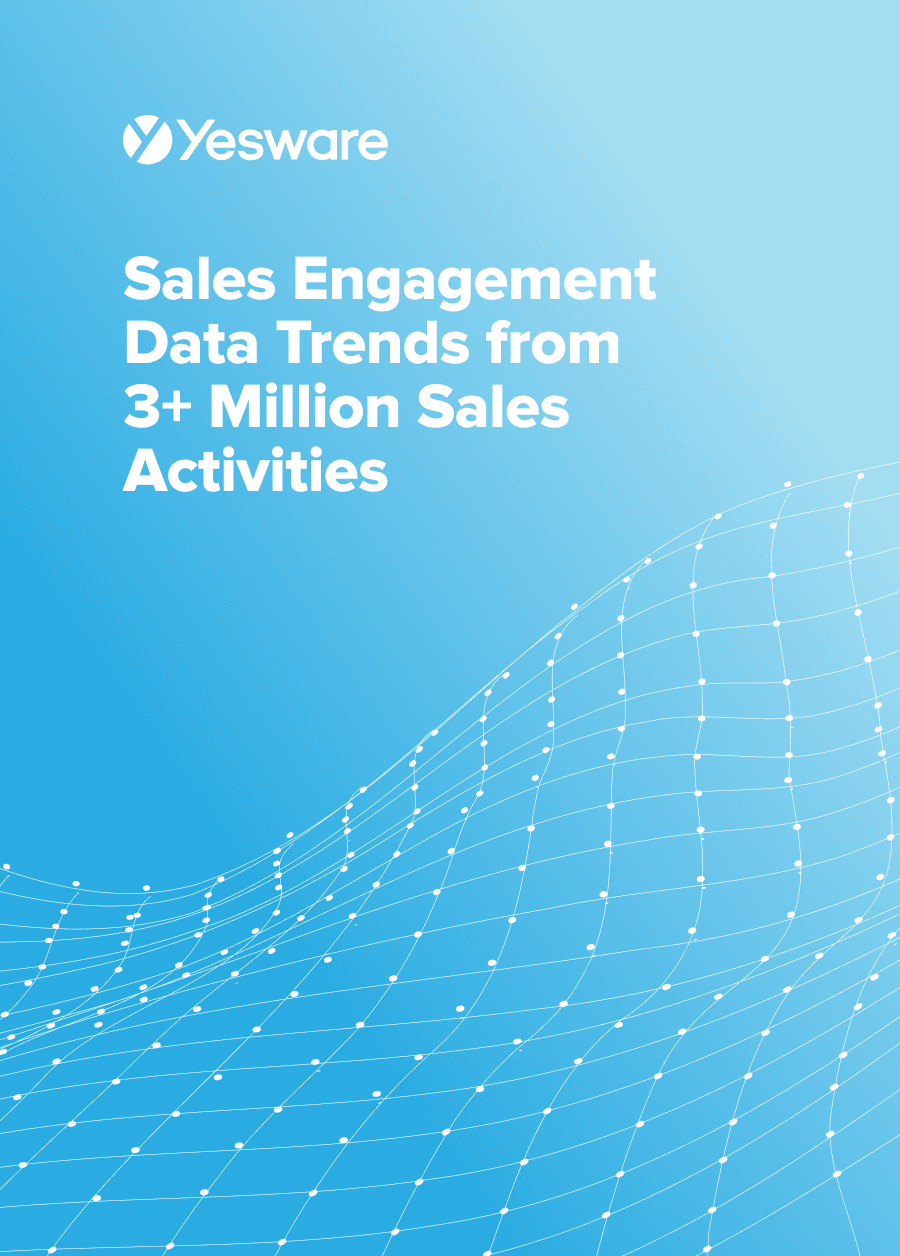 Sales Engagement Data Trends from 3+ Million Sales ActivitiesLooking at millions of tracked email activity over the past few years, this ebook is filled with our top studies and findings to help sales teams accelerate results.
Sales Engagement Data Trends from 3+ Million Sales ActivitiesLooking at millions of tracked email activity over the past few years, this ebook is filled with our top studies and findings to help sales teams accelerate results.
The HEART Framework: Cultivating Deeper Engagement in Conversations
While PBR is excellent for initial outreach, the HEART framework provides a guide for building deeper engagement and trust throughout live conversations (phone, video, in-person). It emphasizes an empathetic and problem-solving approach.
- Hear (H): Actively listen to understand, not just to respond. Pay close attention to their words, tone, and underlying emotions. Avoid interrupting.
- Empathize (E): Acknowledge their feelings and validate their experiences. Show that you understand their pain points or aspirations from their perspective. Use phrases like “I can see how that would be frustrating…” or “It sounds like you’re aiming for…”
- Acknowledge (A): Explicitly confirm what you’ve heard and understood. Paraphrase their statements to ensure accuracy and demonstrate that you’ve processed their input. This builds trust and ensures you’re both on the same page.
- Respond (R): Provide relevant information, ask insightful questions, or offer a solution that directly addresses the needs and challenges you’ve acknowledged. Your response should be tailored and value-driven.
- Trust (T): Build trust through every interaction by being transparent, reliable, and consistent. Follow through on your promises, provide objective advice, and prioritize their best interest over an immediate sale. This is the ultimate goal that underpins every step.
How it works in a conversation:
Prospect: “Our current CRM is just a nightmare to use. My sales reps complain constantly about how slow it is, and they never log anything.”
You (H – Hear): (Listen intently, nodding if on video)
You (E – Empathize): “It sounds incredibly frustrating when a system that’s supposed to help actually becomes a hurdle for your team.”
You (A – Acknowledge): “So, if I’m hearing correctly, the slowness and low adoption rates are really impacting your reps’ willingness to use it, ultimately affecting data quality?”
You (R – Respond): “That’s a very common challenge we see. Many sales teams struggle when their CRM adds friction. Our platform, [Your Product Name], is specifically designed for intuitive user experience and automates logging, which often leads to 80% higher adoption rates and accurate data. How critical is it for your team to have seamless data capture right now?“
You (T – Trust): (By consistently following these steps and delivering on promises, you build trust over time, leading to greater openness and a smoother sales process.)
By integrating the PBR approach for impactful initial outreach and the HEART framework for meaningful ongoing conversations, sales professionals can systematically enhance their personal selling capabilities and drive more successful, relationship-driven outcomes.
5 Personal Selling Examples That Are Endorsed by Prospects
1. The Candid Close — Give Them a Reason Why
Nothing’s worse than being invited to a meeting without an agenda that truly applies to us.
It’s estimated that we spend 31 hours in unproductive meetings every month. And in every meeting, 73% of people do other work because they don’t relate to the content.
When we’re in control of deciding whether or not to go, we’re going to say no.
Unless we’re given a good reason why it’s worth our time.
In the email below, a Yesware account executive adds two clear reasons for a meeting that help him transition from his Benefit to Request:
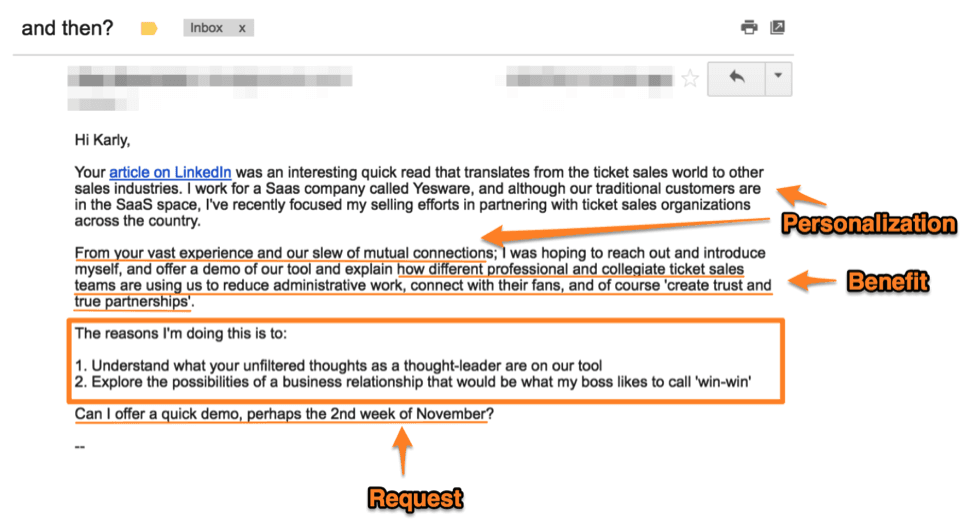
Email tracking revealed to this sender that this email was opened multiple times and the link was clicked. So he probably wasn’t surprised when he got this back:
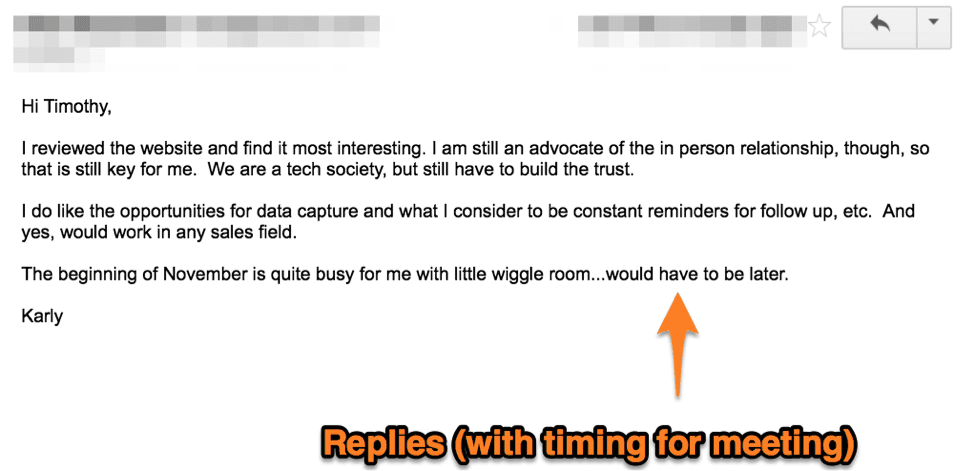
Pro Tip: If your recipient published anything on LinkedIn recently, reference it, link to it, and show you read it with a connecting statement (all in the first paragraph above).
2. Crash My Calendar (Seller Turned Singer-Songwriter)
Hearing our favorite song makes us feel good. Neuroscientists at McGill University discovered that it releases dopamine, a chemical that controls our reward and pleasure centers.
“These findings provide neurochemical evidence that intense emotional responses to music involve ancient reward circuitry in the brain,” says Dr. Robert Zatorre, neuroscientist at The Neuro. “To our knowledge, this is the first demonstration that an abstract reward such as music can lead to dopamine release.”
Which is why emailing a prospect with lyrics from a favorite song — adjusted to them and their business needs — puts a smile on their face and a reply in your inbox.
Here’s an example from one of our account executives:
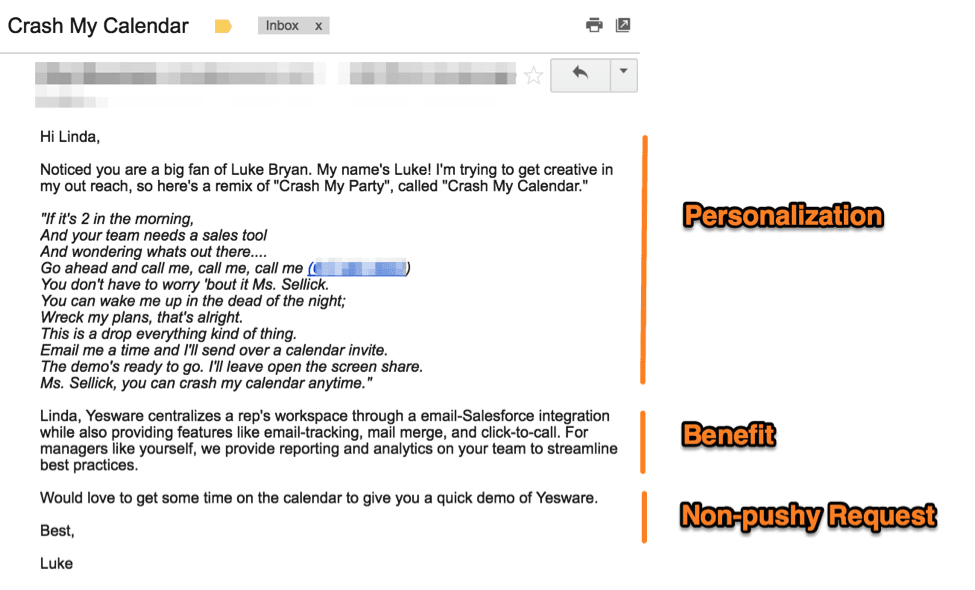
And what Luke got back:
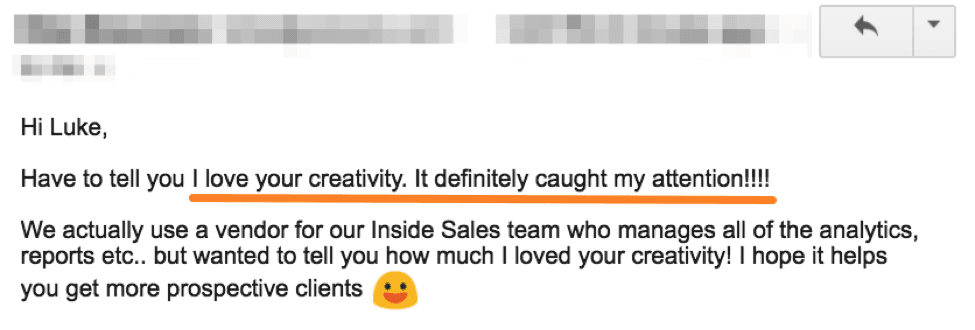
How to do it: Find their favorite band (try Facebook). Look up a song by said band, then tweak the chorus to your value prop.
3. Everyone Has the Same Achilles Heel: Competitors
We’re all constantly working to meet the needs of our target market and stay ahead of competitors at the same time.
It’s a difficult task, and it comes up on all teams across all industries.
Because it’s universal, you can use it for any prospect you’re emailing.
Give their pain point a nudge, then show them how you can fix it.
Here is a good example of personal selling from a Sr. Business Development Rep at Influitive:
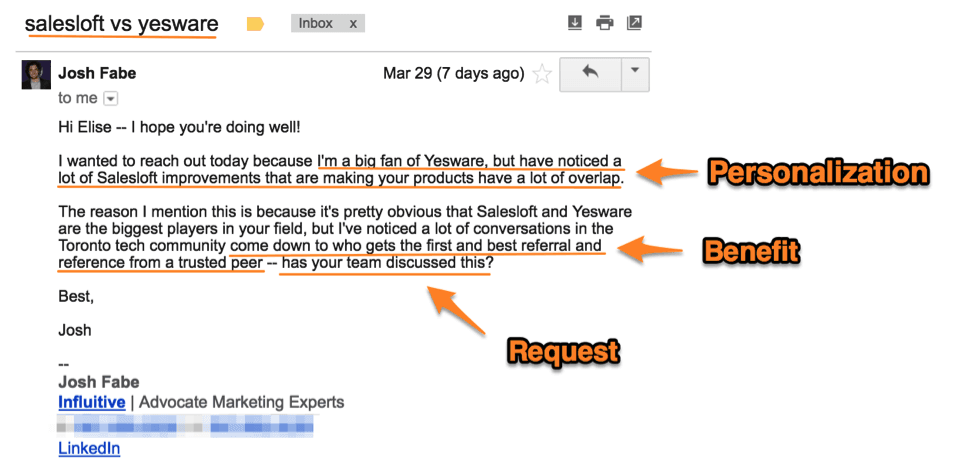
There are two important things that Josh does well:
- Goes beyond simply naming a competitor by pointing out a very specific weak spot. This is what delivers true value, along with a very specific way to solve the problem.
- Asks a question instead of requesting my time. This is a good technique to use if you’re creating a drip campaign that you’ll automate. Work up to asking for a meeting.
How to do it on your own:
- Find their competitor.
- Identify one weak spot where you can help, and make it specific.
- Ask a question that is relevant, would likely be answered by a “no,” but should be a “yes.” If it’s clear you have the intel to get them to “yes,” boom – there’s their incentive to answer.
4. Connecting on a Human Level — What’s Bothering Them?
Some days, it can feel like the world is out to get you.
Personal selling lets you turn this around for someone by showing them you’re on their side.
Check out this email from our Account Executive Clare Durkin:
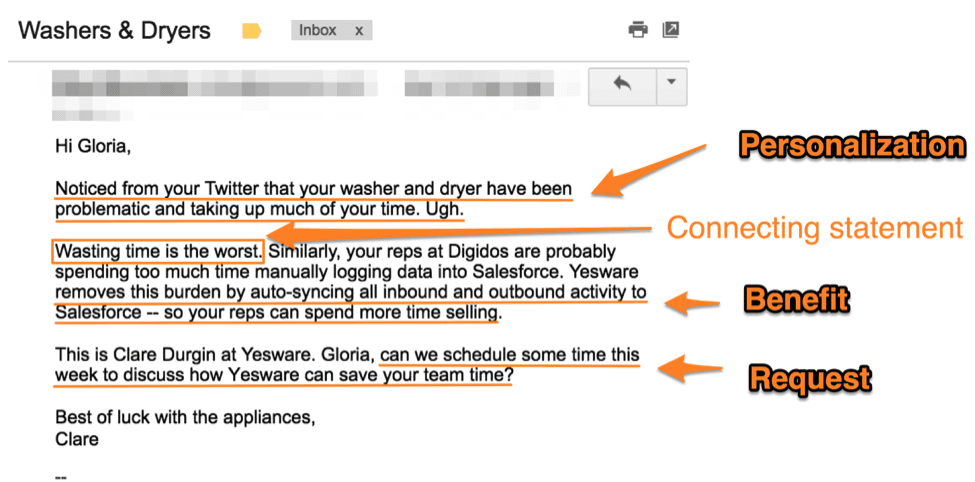
How to do it on your own: Find something that’s been bothering your prospect (ideally outside of work), then use a high-level connecting statement to tie it to a pain point on their team. Here, the connection is wasted time. In this case, it’s okay to ask for a meeting, because:
It’s the fastest way to help them solve the problem.
Here’s what Gloria replied back:
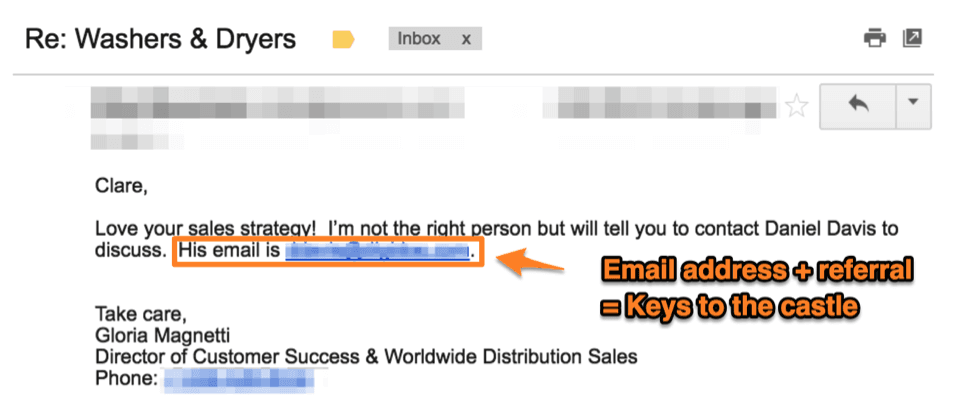
5. Bringing In Their Favorite Movie
What’s your favorite movie?
Think about it.
Now, how would you feel if someone acknowledged your love for this movie and geeked out with you about it?
You’d probably be impressed, and if it came through your inbox, it would be a welcome reprieve from typical business emails.
Here’s an email sent by our sales consultant Alex (and the reaction he got back):
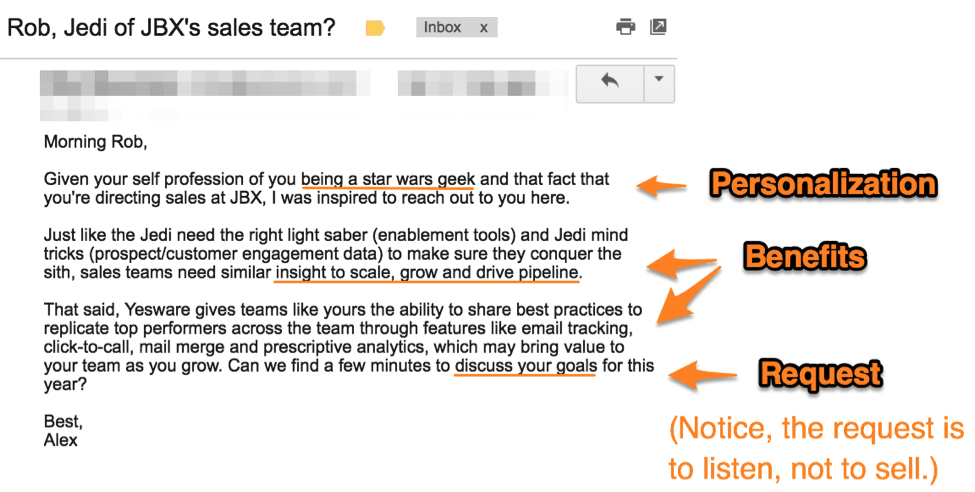

How to do it: Find their favorite movie (try Facebook and Twitter). Identify a character and at least one well-known attribute that you can relate back to your own product or service (through metaphor). What end benefit do they both share?
Here’s how it works in Alex’s email:
Character: Jedi → Salespeople at JBX
Attribute 1: Lightsaber → Sales enablement tool
Attribute 2: Mind tricks → Engagement data
Shared end benefit: Success (whether it’s conquering the sith or scaling and growing a team).
Note: This technique works best for movies where there’s a clear protagonist and antagonist.
That’s all for now. Do you have any examples of emails that worked for you? We’d love to hear from you!
Takeaways:
- “Personal selling” = Finding out who they are & what their needs are, then catering your initial outreach to that. Your first email should start a conversation where you listen.
- Move away from features and identify your value prop. What’s the end benefit?
- Lead with them, not you.
- Use a tool like email tracking to see when they’re opening your emails.
Personal Selling in the Modern Era: High-Tech Meets High-Touch
The notion that digital advancement diminishes the need for personal selling is a misconception. In fact, technology has dramatically enhanced the power and reach of personal selling, transforming it into a sophisticated blend of human connection and intelligent automation. Today’s most effective salespeople seamlessly integrate high-tech tools to deliver high-touch experiences, making personal selling more efficient, insightful, and impactful than ever before.
Leveraging Technology: Empowering Personal Selling
Modern sales technology doesn’t replace the salesperson; it empowers them. These sales tools provide the infrastructure and intelligence needed to execute personal selling at scale and with precision:
- CRM (Customer Relationship Management) Systems: CRM strategy serves as the central nervous system for sales operations. CRMs store all customer data, track every interaction, manage pipelines, and provide a holistic view of the customer journey. This wealth of data allows salespeople to approach prospects with informed context, personalize conversations, and manage relationships more effectively throughout the sales cycle.

- Sales Engagement Platforms (SEPs): Platforms like Yesware are specifically designed to streamline and enhance multi-channel outreach. They enable salespeople to automate repetitive tasks like follow-up emails, track engagement (opens, clicks, replies), and manage complex communication cadences. This frees up reps to focus on the high-value, personalized interactions that only a human can deliver, such as deep discovery calls or objection handling. Yesware’s analytics, for instance, can reveal which personalized messages resonate most, helping to refine your high-touch strategy.

- Sales Intelligence Tools: These tools provide rich data on prospects, companies, and market trends. They help salespeople identify ideal buyers, uncover pain points, and discover trigger events (like new funding or leadership changes) that signal a prime opportunity for a personalized approach. This pre-call research allows reps to initiate conversations with immediate relevance and credibility.
- AI Sales Coaches and Conversation Intelligence: The cutting edge of sales technology often involves AI-powered sales coaches and conversation intelligence platforms. These tools analyze mock calls, live or recorded sales calls, transcribing conversations, and providing real-time or post-call insights. AI coaches can:
- Identify areas for improvement: Flag instances of excessive talk time, filler words, or missed opportunities to ask discovery questions.
- Provide personalized feedback: Offer tailored suggestions based on a rep’s unique conversational patterns.
- Automate note-taking: Free up reps to focus on the conversation rather than administrative tasks.
- Analyze sentiment: Gauge the emotional tone of both the rep and the prospect, offering insights into engagement levels.
- Curate best practices: Highlight excerpts from top-performing calls as examples for the entire team to learn from. This allows for continuous, data-driven skill refinement.
Digital Channels for Personal Selling: Expanding the Reach
Personal selling is no longer confined to face-to-face meetings. Digital channels have expanded its reach and adaptability, allowing for personalized interactions regardless of geographical boundaries:
- Video Calls: Platforms like Zoom, Google Meet, or Microsoft Teams replicate much of the human connection of in-person meetings, allowing for visual cues, enhanced rapport building, and dynamic presentations without the need for travel. This is crucial for complex B2B sales.
- Personalized Email: Far beyond mass marketing blasts, personalized emails, often managed through SEPs, allow salespeople to send highly tailored messages that directly address a prospect’s specific needs, recent activities, or shared connections. This channel is excellent for initial outreach, follow-ups, and delivering targeted content.
- LinkedIn and Social Selling: Professional networking platforms offer unparalleled opportunities for personal selling. Salespeople can research prospects, engage with their content, offer insights, and build relationships that eventually lead to direct, one-on-one sales conversations. This proactive engagement, known as social selling, builds credibility and trust before the traditional “sales” process even begins.
Data-Driven Personalization: Insights That Enhance Interaction
The true power of modern personal selling lies in its ability to leverage data. Insights gathered from CRM, SEPs, and sales intelligence tools enable a level of personalization previously unimaginable:
- Understanding Prospect Behavior: Tracking email opens, link clicks, website visits, and content downloads provides critical behavioral data. This allows salespeople to understand what content resonates, what topics pique interest, and when a prospect is most engaged, enabling timely and highly relevant follow-ups.
- Tailored Messaging: Data about a prospect’s industry, role, company size, existing tech stack, and even recent news can be used to craft messages that feel custom-made. This moves beyond generic “Hi [Name]” to “Hi [Name], I noticed [Specific Company News] and thought you might be interested in how [Our Solution] helped [Similar Company] with [Relevant Challenge].”
- Anticipating Needs: By analyzing patterns across successful deals and using predictive analytics, salespeople can anticipate a prospect’s needs and objections even before they vocalize them, allowing for proactive, value-driven conversations.
Scalable Personalization: Efficient High-Touch
One of the biggest breakthroughs technology offers is the ability to achieve personalization at scale. Salespeople can use templates, automation, and smart triggers to deliver individualized messages and follow-ups to a larger number of prospects without losing the personal touch. This means more leads can be nurtured with quality interactions, accelerating the sales cycle and increasing overall productivity.
Measuring Success: Key Metrics for Personal Selling
To truly optimize your personal selling efforts, it’s essential to move beyond intuition and rely on quantifiable data. Tracking specific sales metrics and Key Performance Indicators (KPIs) provides invaluable insights into what’s working, where improvements are needed, and how your personal selling strategies are contributing to overall business goals.
Here are the key metrics to monitor for personal selling performance:
- Conversion Rates (at different stages): This tracks the percentage of prospects that successfully move from one stage of your personal selling process to the next. For example, Prospecting to First Contact, First Contact to Discovery Call, Discovery Call to Proposal, or Proposal to Close.

-
- Why it matters: Pinpoints specific strengths and weaknesses in your personal selling process. A low conversion rate at a particular stage indicates a bottleneck that requires targeted coaching or strategy adjustment.
- Average Deal Size: This measures the average revenue generated per closed-won deal.

-
- Why it matters: While personal selling might be more expensive per contact, a higher average deal size can justify the investment. It indicates the sales team’s effectiveness in upselling, cross-selling, and selling higher-value solutions.
- Customer Lifetime Value (LTV): This metric projects the total revenue a customer is expected to generate throughout their relationship with your company.

-
- Why it matters: Personal selling often leads to stronger relationships and higher customer satisfaction, which directly translates to increased LTV through repeat purchases, renewals, and expanded contracts. It highlights the long-term return on your personal selling investment.
- Customer Satisfaction (CSAT) or Net Promoter Score (NPS): These surveys gauge how satisfied customers are with their buying experience and how likely they are to recommend your product or company.
- Why it matters: High CSAT/NPS scores often correlate with effective personal selling that prioritizes understanding needs and building trust. Satisfied customers are also more likely to become advocates, reducing future sales cycle lengths through referrals.
- Time-to-Close: This measures the average duration from a lead entering your pipeline to the deal being won.
-
- Why it matters: A shorter time-to-close indicates greater sales efficiency and faster revenue realization. Personal selling, when optimized, can accelerate complex sales by clarifying needs and overcoming objections more quickly.
- Referral Rates: This tracks the percentage of new business generated through referrals from existing, satisfied customers.
- Why it matters: Strong personal selling builds excellent customer relationships, leading to more referrals. Referred leads are often highly qualified and have significantly shorter sales cycles and higher conversion rates, making them incredibly valuable.
- Quota Attainment: This standard sales metric measures the percentage of the sales quota achieved by individual salespeople or the team.
- Why it matters: It’s a direct measure of sales team productivity and efficiency. While influenced by many factors, effective personal selling is a core driver of consistent quota attainment.
By diligently tracking and analyzing these metrics, sales leaders can gain deep insights into the effectiveness of their personal selling strategies, identify areas for improvement, and continuously refine their approach to maximize revenue and customer satisfaction.
This guide was updated on June 5, 2025.
Get sales tips and strategies delivered straight to your inbox.
Yesware will help you generate more sales right from your inbox. Try our Outlook add-on or Gmail Chrome extension for free, forever!
Related Articles
Casey O'Connor
Casey O'Connor
Melissa Williams
Sales, deal management, and communication tips for your inbox

